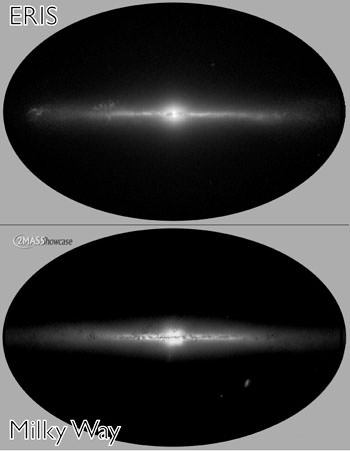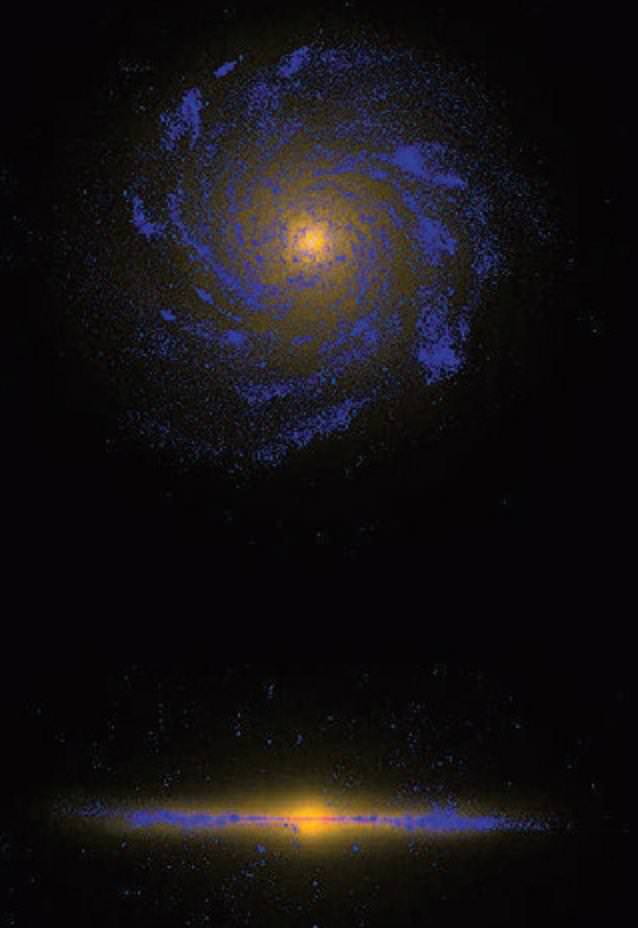[/caption]
In as much time as it takes to give birth to human life, a supercomputer and a team of researchers at the University of California, Santa Cruz, and the Institute for Theoretical Physics in Zurich have given rise to the first simulation of the physics involved in galaxy formation that produced the Milky Way. They named their child Eris…
“Previous efforts to form a massive disk galaxy like the Milky Way had failed, because the simulated galaxies ended up with huge central bulges compared to the size of the disk,” said Javiera Guedes, who recently earned her Ph.D. in astronomy and astrophysics at UC Santa Cruz and is first author of a paper which has been accepted for publication in the Astrophysical Journal.

And “seven sisters” were involved in the project, too. NASA’s state-of-the-art Pleiades supercomputer took on the task of 1.4 million processor-hours. But the calculations didn’t stop there. Simulations on supercomputers at UCSC and the Swiss National Supercomputing Center were involved, too. “We took some risk spending a huge amount of supercomputer time to simulate a single galaxy with extra-high resolution,” Madau said.
For over two decades, attempts at creating the evolution of a Milky Way type galaxy have been just outside the grasp of researchers. They just weren’t able to produce the proper shape, size and population to fit known properties. Thanks to this new breakthrough, support for the “cold dark matter” theory has predominated and the Big Bang theory supported. What gave Eris the edge? Try our now better understanding star formation.
“Star formation in real galaxies occurs in a clustered fashion, and to reproduce that out of a cosmological simulation is hard,” Madau said. “This is the first simulation that is able to resolve the high-density clouds of gas where star formation occurs, and the result is a Milky Way type of galaxy with a small bulge and a big disk. It shows that the cold dark matter scenario, where dark matter provides the scaffolding for galaxy formation, is able to generate realistic disk-dominated galaxies.”
Giving birth to Eris wasn’t an easy task. Through low-resolution simulations, researchers began assembling clumps of dark matter – shaping them into galactic halos. From there they selected information on a halo with similar mass and merger history to our own and “rewound the tape” to its infancy. By focusing on a small area, they were able to add additional particle information and step up the resolution.
“The simulation follows the interactions of more than 60 million particles of dark matter and gas. A lot of physics goes into the code–gravity and hydrodynamics, star formation and supernova explosions–and this is the highest resolution cosmological simulation ever done this way,” said Guedes, who is currently a postdoctoral researcher at the Swiss Federal Institute of Technology in Zurich (ETH Zurich).
What sets Eris apart from its predecessors is the ability to “see” in high resolution / high density. This allows for a more pragmatic approach to star formation and placement. It’s an important consideration, because supernova occur in high density regions and high resolution allows them to be taken into account.
“Supernovae produce outflows of gas from the inner part of the galaxy where it would otherwise form more stars and make a large bulge,” Madau said. “Clustered star formation and energy injection from supernovae are making the difference in this simulation.”
Arise, Eris… Your time has come!
Original Story Source: University of Santa Cruz News. For Further Reading: Forming Realistic Late-Type Spirals in a LCDM Universe: The Eris Simulation.


Um… at the third from bottom paragraph, in the third line, it should be supernovae (plural), as correctly stated in the penultimate paragraph.
Ivan, what happened to “Yo!”?
Er… it’s late and I’m not very enthusiastic tonight.
It is plural: explosionS. “Supernova explosions” is the plural form of “supernova explosion”. Unless you maintain that more than one house builder should be referred to as multiple houses builders.
Maybe I was not clear enough, I was referring to the third line in the third paragraph from the bottom of the page: “[…], because supernova occur in high density regions […]”.
They started out with 14 parameters, and 3 simulations, and we get something that looks like the Milky Way. This is pretty impressive if we knew all the 14 parameters, and the exact physical phenomena. However, I suspect we are not at that happy state yet. For a start, two of the parameters which were not varied for the three simulations relate to dark matter. Also, previous simulations made the core too big, so they looked for extra terms that allow supernovas to blow matter away from the core. It is easily possible to tweak the parameters and add new physics and iteratively come up with a swirly thing that looks about right but for the wrong reasons. We have been through similar false positives with weather simulation.
Much kudos to the team, though. This is a promising start, and if they can do it once, they can tool up to do it thousands of times with minor variations, and see whether this matches the scatter of galaxies we get. If that works, barred spirals, ring galaxies and all, then we are really on the right track.
I think this is like vaulting a fence the first time and not getting the technique correct, the possibility of achieving the result is the main concern. The press release words it as one may think the details of the result is what is most important, but the success of CDM is the breakthrough. Or at least that is my perspective here.
So to me it feels more of a climate model, getting the general process correct long term.
Also, now they know that clustering and supernovas make the crucial difference in the bulge.* I assume also in the central part which AFAIK was the largest stumbling block before. Maybe they can simplify it to be modeled analytically as well.
But, agreed, if it also stumbles into the correct physics neighborhood from the get go, it would be nice too!
* I haven’t looked at the paper, but naively this looks to me like one negative feedback effect that I have heard they suspect from other results, galaxies regulating their growth process. More star formation means more supernovas means less bulge, which I, again naively, would think means less star formation.
If that is a must for predicting the outcome of a CDM model correctly, I would put that down in the “highly suggestive of correct physics” column when adding pros and cons.
First off, don’t miss the actual simulation! It is galacticosmically* magnificent.
Second, it is, I believe, the first CDM model that gets a galactic matter distribution correct. (And it does so splendidly it seems to this layman.) Since this was the last real hideout for alternative gravity ideas as they performed better here, I expect they will now vanish in the fatal attraction of standard cosmology general relativity.
Third, that it took some 9 months to assemble this is also awesome.
—————
* A perfectly cromulent word in the context.
Good find!
The video is well worth a look. You can see that the pitch of the spiral arms appears fairly early in the process, and remains almost constant. I would love to know what the stars remain in the spiral arms in the calculation, or whether they are density waves that move through the stars.
Yes, I was wondering about that too.
But since we are such over-eager pattern detectors, I want to have some objective measure of “spiralness” and follow its distribution over time. Then connecting it to populations or density waves.
I hope someone will make the follow up effort!
Yes, I was wondering about that too.
But since we are such over-eager pattern detectors, I want to have some objective measure of “spiralness” and follow its distribution over time. Then connecting it to populations or density waves.
I hope someone will make the follow up effort!